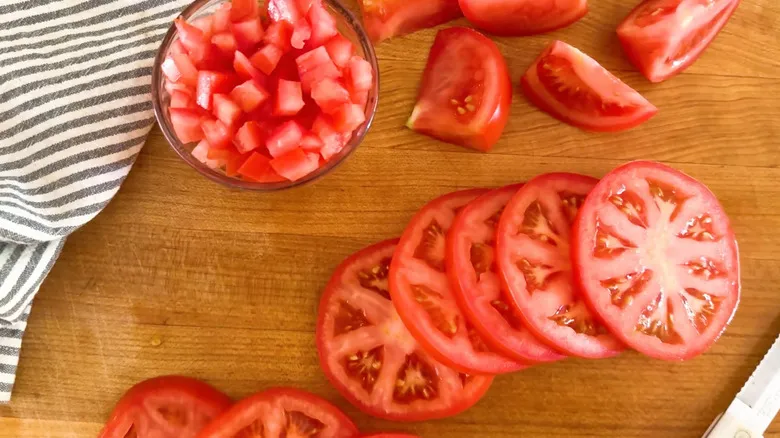When cutting tomatoes, use a serrated blade

"The biggest mistake people make when slicing tomatoes is using the wrong knife," explains Hahn. "It's crucial to use a sharp, serrated knife." The serrated edge easily cuts through the skin of the tomato, resulting in clean, uniform slices. Ensuring your knife is sharp is essential. If you're uncertain about whether your knife needs sharpening, refer to our expert advice on how frequently to sharpen your knives. A sharp serrated knife should glide effortlessly through a tomato; simply move the blade back and forth gently, allowing the teeth to do the work.
Conversely, a dull, straight blade requires more force to break through the tomato's skin, which can lead to crushing the fruit. Dull blades can also slip, resulting in uneven slices or, worse, potential injury to the cook. "A very sharp straight-edge blade can work as well," Hahn notes, "but I always prefer a serrated knife as my first choice."
Slicing, dicing, and wedging: a technique for each

Sliced tomatoes are essential for delicious sandwiches and burgers, yet many people make the error of removing the core first. Hahn clarifies why this is a mistake, as it complicates the slicing process. "The core is what keeps the entire tomato together, so it's best to leave it intact." Instead, begin by trimming off the top of the tomato to create a flat surface. Position your knife parallel to this flat edge and cut slices to your desired thickness.
When it comes to dicing tomatoes, many of us fall into the same soggy trap. Hahn points out, "A common mistake when dicing is leaving the seeds and pulp in the tomato, which can lead to excess moisture." To prevent this issue, start by cutting off the top and bottom of the tomato, then place it flat on a cutting board. Slice it in half and remove the seeds and pulp from the center of each half. Cut the remaining flesh into thin strips, then cross-cut the strips to create small cubes.
Creating tomato wedges begins similarly to slicing. Start by cutting off the top, then place the tomato cut-side up on a cutting board and slice it into as many wedges as you prefer. Hahn advises, "Cut along the core to keep everything intact." By avoiding these common mistakes, you'll have perfectly prepared tomatoes—it's that easy!
Recommended

The Best Pan To Use When Cooking Breakfast Potatoes

12 Tips To Cut Down On Cooking Time

The Sweet Ingredient You Should Try For Flavorful Fried Chicken

Prue Leith's Hack For Cutting Avocados Uses An Unexpected Baking Tool
Next up
